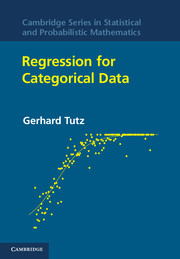Book contents
- Frontmatter
- Contents
- Preface
- 1 Introduction
- 2 Binary Regression: The Logit Model
- 3 Generalized Linear Models
- 4 Modeling of Binary Data
- 5 Alternative Binary Regression Models
- 6 Regularization and Variable Selection for Parametric Models
- 7 Regression Analysis of Count Data
- 8 Multinomial Response Models
- 9 Ordinal Response Models
- 10 Semi- and Non-Parametric Generalized Regression
- 11 Tree-Based Methods
- 12 The Analysis of Contingency Tables: Log-Linear and Graphical Models
- 13 Multivariate Response Models
- 14 Random Effects Models and Finite Mixtures
- 15 Prediction and Classification
- A Distributions
- B Some Basic Tools
- C Constrained Estimation
- D Kullback-Leibler Distance and Information-Based Criteria of Model Fit
- E Numerical Integration and Tools for Random Effects Modeling
- List of Examples
- Bibliography
- Author Index
- Subject Index
7 - Regression Analysis of Count Data
Published online by Cambridge University Press: 05 June 2012
- Frontmatter
- Contents
- Preface
- 1 Introduction
- 2 Binary Regression: The Logit Model
- 3 Generalized Linear Models
- 4 Modeling of Binary Data
- 5 Alternative Binary Regression Models
- 6 Regularization and Variable Selection for Parametric Models
- 7 Regression Analysis of Count Data
- 8 Multinomial Response Models
- 9 Ordinal Response Models
- 10 Semi- and Non-Parametric Generalized Regression
- 11 Tree-Based Methods
- 12 The Analysis of Contingency Tables: Log-Linear and Graphical Models
- 13 Multivariate Response Models
- 14 Random Effects Models and Finite Mixtures
- 15 Prediction and Classification
- A Distributions
- B Some Basic Tools
- C Constrained Estimation
- D Kullback-Leibler Distance and Information-Based Criteria of Model Fit
- E Numerical Integration and Tools for Random Effects Modeling
- List of Examples
- Bibliography
- Author Index
- Subject Index
Summary
In many applications the response variable is given in the form of event counts, where an event count refers to the number of times an event occurs. Simple examples are
number of insolvent firms within a fixed time internal,
number of insurance claims within a given period of time,
number of epileptic seizures per day,
number of cases with a specific disease in epidemiology.
In all of theses examples the response y may be viewed as a non-negative integer-valued random variable with y ∈ {0, 1, 2, …}. Although in many applications there is an upper bound for the response, because the number of firms or potential insurance claims is finite, the upper bound is often very large and considered as irrelevant in modeling. In other cases, for example, for the number of epileptic seizures, no upper bound is given. In the following some further examples are given.
Example 7.1: Number of Children
The German General Social Survey Allbus provides micro data, which allow one to model the dependence of the number of children on explanatory variables. We will consider women only and the predictors age in years (age), duration of school education (dur), nationality (nation, 0: German, 1: otherwise), religion (answer categories to “God is the most important in man”, 1: strongly agree, …, 5: strongly disagree, 6: never thought about it), university degree (univ, 0: no, 1: yes).
- Type
- Chapter
- Information
- Regression for Categorical Data , pp. 181 - 206Publisher: Cambridge University PressPrint publication year: 2011

